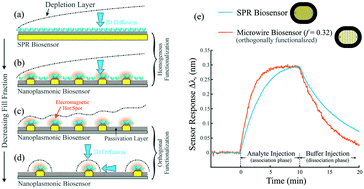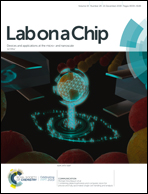Analyte transport to micro- and nano-plasmonic structures†
Abstract
The study of optical affinity biosensors based on plasmonic nanostructures has received significant attention in recent years. The sensing surfaces of these biosensors have complex architectures, often composed of localized regions of high sensitivity (electromagnetic hot spots) dispersed along a dielectric substrate having little to no sensitivity. Under conditions such that the sensitive regions are selectively functionalized and the remaining regions passivated, the rate of analyte capture (and thus the sensing performance) will have a strong dependence on the nanoplasmonic architecture. Outside of a few recent studies, there has been little discussion on how changes to a nanoplasmonic architecture will affect the rate of analyte transport. We recently proposed an analytical model to predict transport to such complex architectures; however, those results were based on numerical simulation and to date, have only been partially verified. In this study we measure the characteristics of analyte transport across a wide range of plasmonic structures, varying both in the composition of their base plasmonic element (microwires, nanodisks, and nanorods) and the packing density of such elements. We functionalized each structure with nucleic acid-based bioreceptors, where for each structure we used analyte/receptor sequences as to maintain a Damköhler number close to unity. This method allows to extract both kinetic (in the form of association and dissociation constants) and analyte transport parameters (in the form of a mass transfer coefficient) from sensorgrams taken from each substrate. We show that, despite having large differences in optical characteristics, measured rates of analyte transport for all plasmonic structures match very well to predictions using our previously proposed model. These results highlight that, along with optical characteristics, analyte transport plays a large role in the overall sensing performance of a nanoplasmonic biosensor.



 Please wait while we load your content...
Please wait while we load your content...